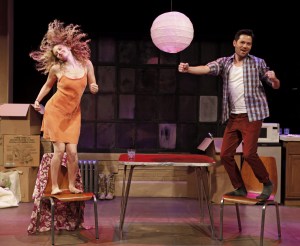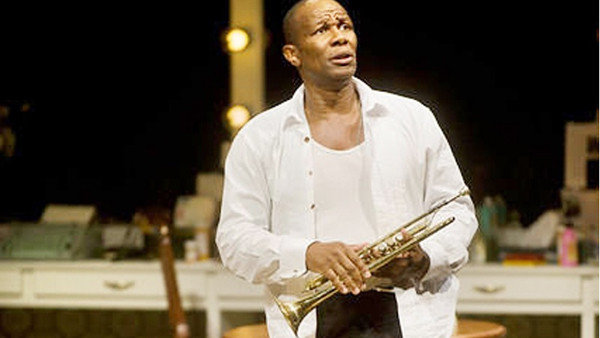Duke Ellington at the Cotton Club (Storyville, two CDs). This hugely important release contains cleaned-up transfers of all surviving radio broadcasts made by Ellington between 1937 and 1939. Most of them have circulated for years, but this is the first time that they’ve ever been made available in a single package. Listening to these performances is like spending a blissful evening in the Wayback Machine. First-class liner notes by Andrew Homzy (TT).
Archives for 2012
CD
GALLERY
Nell Blaine: A Glowing Order (Tibor de Nagy, 724 Fifth Ave., up through Oct. 13). A gorgeous little show of paintings and watercolors by a Hans Hofmann pupil who broke decisively with abstract expressionism, then spent the rest of her life turning out boldly colored still lifes and landscapes that portray the visible world imaginatively but never literally. Not to be missed (TT).
TT: The girl upstairs
In today’s Wall Street Journal I review the Keen Company’s off-Broadway revival of Marry Me a Little and the Broadway premiere of Grace. Here’s an excerpt.
* * *
First performed in 1980, “Marry Me a Little” is a 70-minute-long miniature musical–one set, two actors and a pianist–concocted by Craig Lucas and Norman René. The plot, in which two young apartment dwellers who live on adjacent floors of the same building (Lauren Molina and Jason Tam) dream of finding romantic partners, is as simple and ingenious as is the musical concept. The score consists of little-known songs by Stephen Sondheim, most of which were cut from his shows prior to their New York openings. Neither character speaks a word: Mr. Sondheim does all the work, and does it with his customary virtuosity. It’s quite a trick to uproot his impecccably theatrical songs from their original context and transplant them into a new one, but “Marry Me a Little” pulls the feat off so skillfully that you’d think they’d been written to fit together.
 Mr. Tam is an affable, nice-looking gent who makes a pleasing onstage impression. Ms. Molina, who played Johanna to perfection in the 2005 Broadway revival of “Sweeney Todd,” is something else again, a quirky, angular beauty with a sharp-edged sense of humor whose limbs look as though they’re made of taffy. I last saw her on stage four months ago in the San Diego premiere of “Nobody Loves You” and delighted in her comic energy. She’s just as funny in “Marry Me a Little,” but what you’ll remember here is the intense wistfulness with which she puts across Mr. Sondheim’s famously ambivalent ballads (“Keep a tender distance/So we’ll both be free/That’s the way it ought to be”). Not only does she nail the title song, but I’ve never heard a more affecting performance of “There Won’t Be Trumpets.” Might Ms. Molina be poised for musical-comedy stardom? It certainly looks that way.
Mr. Tam is an affable, nice-looking gent who makes a pleasing onstage impression. Ms. Molina, who played Johanna to perfection in the 2005 Broadway revival of “Sweeney Todd,” is something else again, a quirky, angular beauty with a sharp-edged sense of humor whose limbs look as though they’re made of taffy. I last saw her on stage four months ago in the San Diego premiere of “Nobody Loves You” and delighted in her comic energy. She’s just as funny in “Marry Me a Little,” but what you’ll remember here is the intense wistfulness with which she puts across Mr. Sondheim’s famously ambivalent ballads (“Keep a tender distance/So we’ll both be free/That’s the way it ought to be”). Not only does she nail the title song, but I’ve never heard a more affecting performance of “There Won’t Be Trumpets.” Might Ms. Molina be poised for musical-comedy stardom? It certainly looks that way.
The world has changed greatly since 1980, of course, and Jonathan Silverstein, the director of this revival, has changed “Marry Me a Little” accordingly. In addition to moving the action of the show into the age of smartphones and sexting, he’s toyed with the score, dropping three songs and adding four others, in all cases to excellent effect….
Like “Marry Me a Little,” Craig Wright’s “Grace” takes place on a single set that is meant to represent two identical apartments. That, alas, is all that the two shows have in common. Mr. Wright’s play, which bounced around the regionals for years before reaching Broadway, is a complacent, toothless jeremiad that seeks to skewer modern-day Christians who think that Jesus died to make them rich (“Dear Lord, we just come before you now to thank you for bringing us this amazing opportunity”). It’s the kind of play in which these benighted Babbitts are portrayed as sexually inhibited fatheads who say “heck” a lot….
* * *
Read the whole thing here.
TT: Almanac
“Courage is resistance to fear, mastery of fear–not absence of fear.”
Mark Twain, Pudd’nhead Wilson
TT: Happy happy joy joy
 The first preview of Satchmo at the Waldorf in New Haven went smoothly and satisfyingly. Yes, there were a couple of glitches, but nothing you would have noticed if you weren’t already familiar with the show, and at the end the entire audience leaped to its feet and cheered wholeheartedly.
The first preview of Satchmo at the Waldorf in New Haven went smoothly and satisfyingly. Yes, there were a couple of glitches, but nothing you would have noticed if you weren’t already familiar with the show, and at the end the entire audience leaped to its feet and cheered wholeheartedly.
We have another six preview performances left before next Wednesday’s press opening. No doubt we’ll do a certain amount of tweaking between now and then–that’s how it works–but I’m feeling good today.
I have a couple of shows to see in New York, so I won’t be in New Haven again until Saturday afternoon. If you catch Satchmo in my absence, let me know how it went!
TT: So you want to see a show?
Here’s my list of recommended Broadway, off-Broadway, and out-of-town shows, updated weekly. In all cases, I gave these shows favorable reviews (if sometimes qualifiedly so) in The Wall Street Journal when they opened. For more information, click on the title.
BROADWAY:
• Bring It On (musical, G, closes Jan. 20, reviewed here)
• Evita (musical, PG-13, reviewed here)
• Once (musical, G/PG-13, nearly all performances sold out last week, reviewed here)
OFF BROADWAY:
• Avenue Q (musical, R, adult subject matter and one show-stopping scene of puppet-on-puppet sex, reviewed here)
• The Fantasticks (musical, G, suitable for children capable of enjoying a love story, reviewed here)
• Tribes (drama, PG-13, closes Jan. 6, reviewed here)
IN NIAGARA-ON-THE-LAKE, ONTARIO:
• Misalliance (serious comedy, G/PG-13, far too talky for children, closes Oct. 27, reviewed here)
• Present Laughter (comedy, PG-13, closes Oct. 28, reviewed here)
CLOSING SOON IN SPRING GREEN, WISC.:
• Skylight (drama, PG-13, adult subject matter, closes Oct. 20, reviewed here)
CLOSING SOON OFF BROADWAY:
• Lovers (drama, PG-13, closes Oct. 20, reviewed here)
TT: Almanac
“He was handsome in a way that didn’t mean anything. He had the empty, regular face that you can find in college courses called Economics 10B or Political Science 101, or the sort of face you see on young leading men in the second feature of moving-picture double bills.”
Dorothy Baker, Young Man With a Horn
TT: Coast to coast
Here’s a how-de-do! Satchmo at the Waldorf got written up in the San Francisco Chronicle:
One of the differences between his book and his play, Teachout said, is that while “Pops” makes it clear that Armstrong’s critics were short-sighted, “Satchmo at the Waldorf” is meant to allow audiences to draw their own conclusions about the controversy that raged around the musician.
“If you want to know what I think, you can find that in the book. At the end of the play, I would like the audience to draw their own conclusions–to be thoughtful about what they’ve seen,” he said….
Read the whole thing here.
